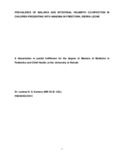| dc.description.abstract | African eggplant is one of the indigenous vegetables with a great potential for improving food security and income generation among rural and urban resource-poor communities. However, its productivity is low partly due to lack of suitable varieties and drought stress. Systematic characterization of the existing African eggplant accessions is therefore required to identify key agronomic and quality traits for its improvement. Existing germplasm of the eggplants have not been evaluated for agronomic potential under water stress and non-water stressed environments. In addition, the nutritional quality of existing accessions and germplasm has not been determined. The objectives of this study were: 1. to evaluate African eggplant accessions for morphological and agronomic traits; and 2. to determine the effect of water stress on growth, yield and nutritional quality of selected African eggplant accessions. Field and greenhouse experiments were conducted in 2014 and 2015 at the University of Nairobi’s Kabete Field Station. In the first objective, 72 African eggplant accessions from four species namely Solanum aethiopicum (50 accessions), Solanum macrocarpon (1 accession), Solanum anguivi (6 accessions) and Solanum species (15 accessions) were characterized in both the greenhouse and field based on the available African eggplant descriptors list. Data were collected on nine quantitative traits (plant height, leaf length, leaf width, fruit length, fruit breadth, fruit weight, number of fruits per plant, chlorophyll content and days to 50% flowering) and eight qualitative traits (growth habit, leaf prickles, leaf hairs, fruit breadth, fruit length, flower colour, fruit shape and fruit position) measured at flowering and fruit maturity stages. In the second objective, a study was conducted in a greenhouse at the University of Nairobi’s Kabete Field Station to determine the genotypic variation in yield and nutritional quality of 20 selected African eggplant accessions grown under water stress (40%, 60% and 80% field capacity) and non-water stress (100% field capacity) conditions. The experiments were laid
xvi
out in a randomized complete block design with three replications. Data was collected on growth components (plant height, stem girth, single leaf area and fruit weight), physiological parameters (stomatal conductance, canopy temperature, leaf relative water content and chlorophyll content) and chemical components (β-carotene, vitamin C, total soluble solids, titratable acidity, pH, Mg, Ca, Fe and Zn measured at vegetative, flowering and fruit maturity stages. The analysis of variance indicated significant differences (P<0.05) for most of the accessions grown in the field and greenhouse. Fruit length was significantly (P<0.05) and positively correlated with fruit breadth (r = 0.59 and 0.60), fruit weight (r =0.72 and 0.73) and leaf blade width (r =0.34 and 0.28 for field and greenhouse grown accessions, respectively). However, fruit length correlated negatively but highly significantly with the number of fruits per plant (r = -0.32 and -0.31 for field and greenhouse grown accessions, respectively). On the other hand fruit length was positively correlated with leaf blade length (r = 0.09 and 0.09) and plant height (r = 0.15 and 0.16) while days to flowering had a positive correlation with SPAD value (r = 0.08 and 0.06), respectively, for field and greenhouse grown accessions. Cluster analysis placed the accessions into two cluster groups with cluster I having 51 accessions and cluster II having 21 accessions. Both in the field and greenhouse, 87.5% of the accessions showed an upright growth, intermediate growth habit (9.7%) and prostrate growth habit (2.8%). Accessions with leaf prickles and leaf hairs were 68.1% and 70.8% respectively. Shannon-Weaver diversity index (H’) estimates for the qualitative characters in the field and greenhouse were high (H’>0.750). Principal component analysis showed that fruit parameters (fruit breadth and fruit position), flower parameter (flower colour) and leaf parameters (leaf hairs and leaf prickles) were important traits which distinctively separated the eggplant accessions. Results showed high yields in accessions RV100200, GBK050572, RV100456, RV100256 and RV100239 while the lowest yield was seen in accession RV100335. Water stress
xvii
significantly decreased fruit yield (16.6%), fruit weight (13.8%), stem girth (31.9%), plant height (20.1%), single leaf area (17.9%), stomatal conductance (57.7%), leaf relative water content (37.2%), contents of chlorophyll (12.6%), pH (6%), magnesium (43.5%), calcium (43.9%), iron (47.3%) and zinc (18.9%). However, it increased β-carotene concentration (29.5%), vitamin C (6.03%), titratable acidity (16.7%), total soluble solids (14.9%) and canopy temperature (19.7%). African eggplant accessions varied in morphological growth, fruit yield and nutritional quality. Six key traits identified for characterizing eggplant accessions were leaf hairs, leaf prickles, fruit shape, fruit breadth and flower colour. Water stress decreased growth, fruit yield, macronutrients (Ca and Mg) and micronutrients (Fe and Zn) but increased β-carotene, vitamin C and total soluble solids | en_US |



